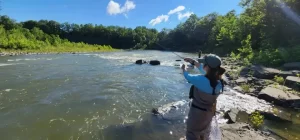There’s no shortage of ways to catch bass, and each method offers its own excitement. At first, fly fishing for bass may seem unconventional, as fly fishing is often associated with delicate presentations and tiny flies, while bass fishing brings to mind crankbaits, bobbers, and tournaments. However, pairing fly fishing with bass is both challenging and exhilarating, making bass one of the best species to target with a fly rod across the country.
Fly fishing for bass is distinct from fly fishing for trout. Trout tend to be more selective, requiring specific flies and techniques. Bass, on the other hand, are less particular and will often go after anything flashy that catches their eye. When bass strike, it’s usually a dramatic and powerful hit, offering a thrilling experience.
Despite the excitement, fly fishing for bass comes with unique challenges. It involves different techniques and flies compared to trout fishing and may require anglers to explore new waters, including lakes, ponds, and warmer rivers. Once hooked, bass put up a fight that is unlike any other species, making them a rewarding target on a fly rod.
Bass Species to Target with a Fly Rod
There are three main species of bass commonly targeted while fly fishing: smallmouth bass, largemouth bass, and striped bass (stripers).
- Smallmouth Bass: Smallmouth bass are bronze to greenish-brown and are often found in cooler waters, including spring-fed streams and deep rivers. Their aggressive nature and strong fight make them a popular target for fly anglers.
- Largemouth Bass: Largemouth bass, with their distinctive greenish color and black lateral line, prefer warmer, shallower water. These bass can often be found near shorelines, lily pads, and shallow bays, offering great opportunities for fly fishing.
- Striped Bass (Stripers): Found along the Atlantic coast and in waterways like the Hudson River, stripers thrive in freshwater, brackish, and saltwater environments. These fish grow large—sometimes over forty pounds—and require heavier gear than the other bass species. Stripers can be identified by their dark horizontal stripes and shiny white underbelly.
Fly Fishing Gear for Bass
Fly fishing for bass doesn’t have to be overly complicated. A 9-foot, 5-weight rod and reel will suffice in many situations. However, bass-specific gear is recommended, particularly when casting heavier flies or streamers. A fast-action, 9-foot rod in the 6- to 8-weight range, such as the Orvis Helios or the JP Ross Coherence, is ideal for targeting bass. For stripers, a beefier setup like the Orvis Helios D 10-weight fly rod is necessary to handle their size and strength.
Matching the rod with the right fly line is critical. The Scientific Anglers Amplitude Smooth Titan Long Two Size Heavy Line and the Cortland Bass Intermediate Specialty Series line are both excellent options, designed to cast large, wind-resistant flies with ease. Leaders and tippets should be in the 2x to 4x range, with a 7.5- to 9-foot leader length, depending on the size of the bass being targeted.

Best Flies and Techniques for Bass Fishing
Bass are aggressive feeders, which is one reason they are such a joy to fish for. The key to success is getting the fly in front of them, and there are three main types of flies typically used to target bass: poppers, nymphs, and streamers.
- Streamers: Wooly buggers are a versatile choice for beginners. Cast them parallel to the bank and use firm, focused strips to imitate an injured baitfish. Unweighted wooly buggers work well near the surface, while beadhead versions or weighted lines can help get the fly deeper into the water column.
- Poppers: Blockhead poppers create surface motion that mimics prey in distress, drawing the attention of bass. Cast past likely hiding spots and retrieve with short, deliberate motions. Deer hair poppers, often used near weed beds or submerged trees, create a softer effect in the water, making them another excellent option for surface action.
- Nymphs: In rivers, dead-drifting a large black stonefly nymph can entice a bass. A slow-retrieve technique that mimics insect movement through the water column can also be effective, especially when bass are not responding to more aggressive streamers.
Conditions and Cover for Bass
Bass are often found near cover such as weed beds, lily pads, and submerged structures. Cast towards these areas and retrieve the fly back, focusing on any natural structure in the water, such as drop-offs or submerged boulders. Bass also tend to gather near moving water, like inlets or culverts, where oxygen and food are more abundant. These spots, especially after rainfall, can offer prime bass fishing opportunities.
Preparing for the Fight
Hooking into a bass on a fly rod often results in a hard hit. However, the hook set should be more controlled than the aggressive yank used in spin fishing. A bass typically vacuums up its prey, so the hook is usually securely lodged in the mouth. To set the hook, lift the rod and take up slack with the left hand, keeping the line tight while managing the fight. Bass are known for their powerful runs and frequent jumps, making line management essential.
Though bass are resilient fish, proper handling is important to ensure their survival after release. Snap a quick photo, appreciate the experience, and return the fish to the water for the next angler to enjoy.
Catching bass on a fly rod is an exhilarating experience that offers a new challenge for anglers, especially those accustomed to trout fishing. With the right gear, flies, and techniques, landing that first bass can be an unforgettable achievement.
Image/Source: WOS





